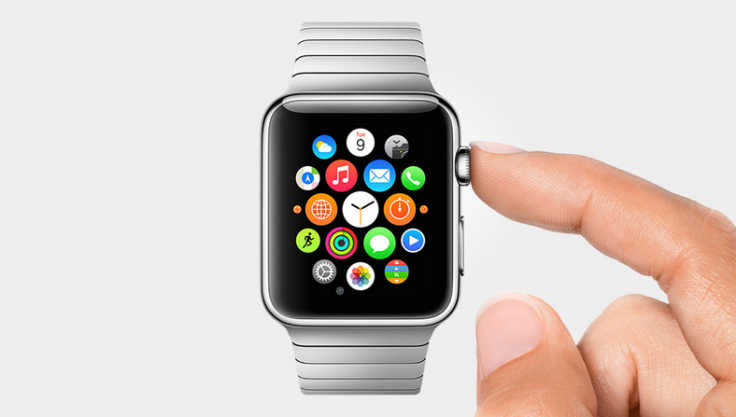Wall Street Gives Apple Inc. (AAPL) Shares Temporary Boost After Seeing iPhone 6, Apple Watch And Apple Pay

Wall Street has seen the Apple Watch, Apple Pay and a couple of jumbo iPhone 6 phablets and apparently likes what it sees. Apple Inc. (NASDAQ: AAPL) stock jumped by more than three points Tuesday after CEO Tim Cook unveiled the iPhone 6 and Apple Watch. The sudden jump came less than an hour after Cook took the stage in California and initially seemed to break the company’s bad luck on Wall Street on previous release days.
Share price opened at 99.11 Tuesday morning but surged to 101.66 at press time, though the number continued to fluctuate through the afternoon. Financial forecasters predicted share price would initially jump only to decline again, possibly to levels lower than Tuesday’s open, as time went on. Indeed, AAPL may have peaked when Apple Pay was released only to falter when Cook announced the Apple Watch.
$AAPL heading downwards after Watch announcement, peaked w Apple Pay pic.twitter.com/OMvz1idhKU
— Rohit (@rohit_x_) September 9, 2014By 3:08 EDT, two hours after the Apple executive turned up on stage, share price had fallen to 96.90. When U2 took the stage after Cook's presentation, Apple shares were worse off than they were at the morning bell.
#Apple stock is now NEGATIVE on the day. #BlameBono? $AAPL pic.twitter.com/oLQxKdrLGa
— Amber Kanwar (@amberkanwar) September 9, 2014AAPL shares were at 97.99 when the closing bell rang Tuesday.
"Obviously the new sizes should help to feed into what should be a very strong upgrade cycle in the U.S., Apple's most important market, but the market obviously reacted more negatively to the Watch unveiling, perhaps just based on the initial look of the product,” said Walter Piecyk, a research analyst at BTIG.
"It's hard to justify a new product category unless you've used it, but perhaps the look of the new product was not as interesting as people had hoped. There's obviously more to these products than their look, the initial look relative to the experiences that are out there for that product, but it resulted in that reaction to the stock, from some investors."
Apple shares traditionally climb in the weeks leading up to a major announcement only to struggle in the days and weeks that follow. Stock, on average, has climbed by 5.2 percent before previous iPhone announcements only to drop five of the previous seven times, with an average 1.8 percent decline one month after the announcement, according to Bespoke Investment Group.
Before Apple unveiled the iPhone 5S and 5C on September 2013 company stock climbed by 11 percent only to fall by 2.3 percent on the day of the announcement and again by 5.4 percent the day after. Shares were down by 11 percent by the following week, though the price rose again by 12 percent within three months.
Tuesday’s Apple announcement didn’t follow that trend. Share price rose 38 percent starting in April, with Apple reporting strong quarterly results and preparing a 7-for-1 stock split. That luck ran out last week, though, when analysts warned to sell stock before the big iPhone announcement and cybersecurity experts speculated that a flaw in the iCloud made it possible for hackers to steal nude images on high-profile celebrities.
"Apple's stock has reacted negatively to products in the past, but what's ultimately important is if they can grow revenue and earnings,” Piecyk added. “The most important products for that were the new phones that were launched.”
Apple stock doubled in the year after the first iPhone debuted in 2007. Share price jumped again by 65 percent three years later with the dawn of the iPad.
Samsung Electronics Co. (OTC: SSNFL), Apple’s chief competitor, quietly watched as its own stock price remained static at 1,175.00 through the day Tuesday. Despite Apple’s stock dive the new products gives the company reason to be optimistic, with Craig Elimeliah, the director of creative technology at the integrated agency RAPP, explaining that competitors will be on their heels.
“Now that Apple’s line-up matches the screen sizes and acceleration of competitive units, it will offer a much more compelling product mix than any other competitor can with a more solid and holistic mobile ecosystem,” he said. “Samsung and others can do very little at this point to try and out-do the iPhone. The software and hardware mix is way too hard for the competition to match.”
© Copyright IBTimes 2025. All rights reserved.



















